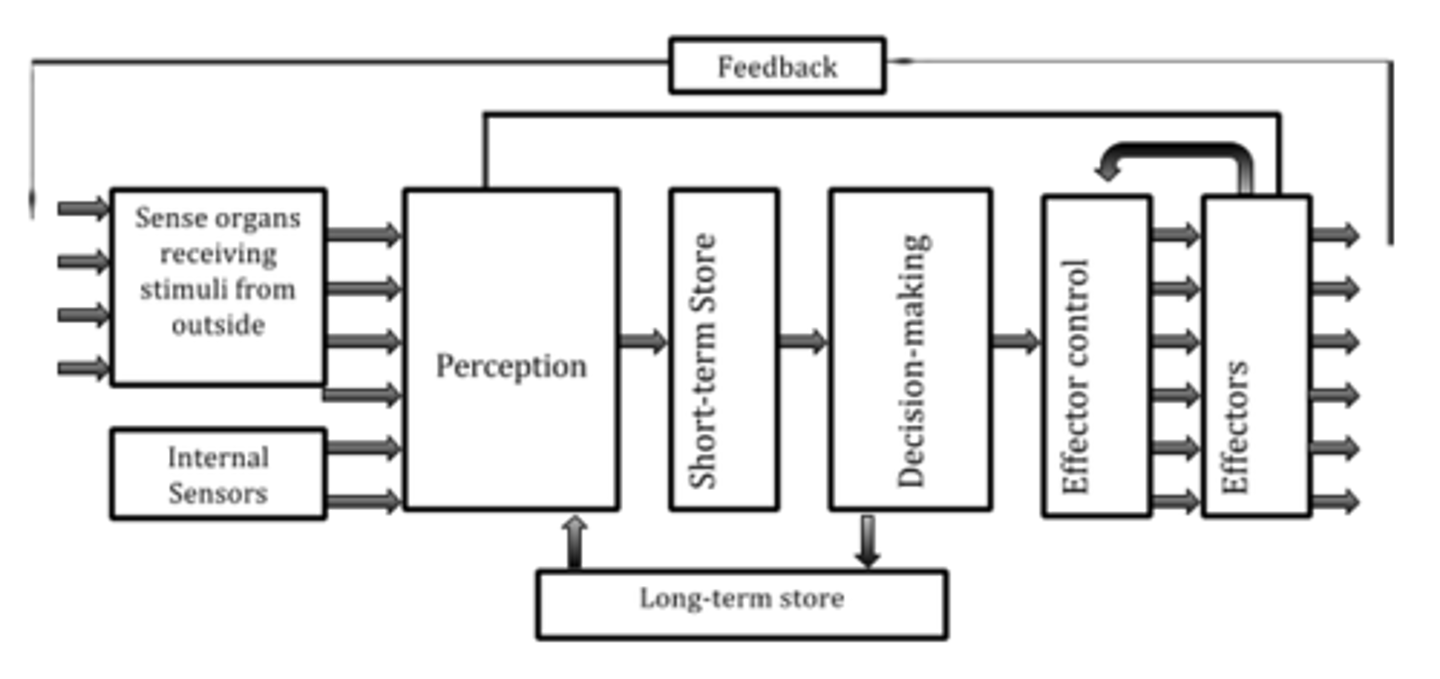5.2 Information processing
1/41
There's no tags or description
Looks like no tags are added yet.
Name | Mastery | Learn | Test | Matching | Spaced |
|---|
No study sessions yet.
42 Terms
simple model
input --> decision making --> output
Welford's model of information processing
1.) Sense organs & internal sensors
2.) Perception -> STM -> decision making->
(long term memory)
3.) Effector control -> effectors

components associated with sensory input
exteroceptors, interoceptors (proprioceptors)
exteroception
- Outside
- Senses: In sport this is information that a performer can see, hear and touch.
interoception
- Within
- Information inside the body: in sport, the heart, lungs and central nervous system play a major role.
- Detection of changes in CO2, blood pressure and movement is fed-back to the CNS.
proprioception
- Within
- Detect and inform CNS for body position and limb movement
- Correct movements (technique) and power of movement (muscle fibre recruitment)
perception
process by which the brain makes sense of stimuli
signal detection process
Referred to as the detection- comparison-recognition process (DCR)
1.) Brain is making sense of the stimulus received.
2.) STM looks anticipated stimuli to help select which information to take in.
3.) LTM helps avoid random patterns that distract from the important information (noise etc)
4.) Selected stimuli is compared to LTM to select an appropriate response.
short term sensory store
Collects information from senses
Unlimited capacity, very limited time (0.5 secs)
short-term memory
activated memory that holds a few items (max 10) for a short period of time (7-10 secs) before the information is stored or forgotten
long-term memory
can hold unlimited pieces of information and the information can be stored for a lifetime. LTM retrieves a memory and sends information to STM to allow movement or a skill to be carried out.
selective attention
the ability to focus on only the important stimulus from among all sensory input
methods of improving memory
association, brevity, clarity, chunking, coding, practice, rehearsal, organisation
association
new learning is linked to skills players already know
brevity
keep it simple
chunking
putting bits of information together to use less of your capacity; learning to butterfly swim
coding
save the memory in a particular "form" (word, number, movement)
clarity
keep it clear
practice
- enables you to make information in the LTM permanent
- coaches will remind players of previous success -> to improve
rehearsal
repeating information over and over
organisation
chaining; breaking a complex skill down into.a series of simpler actions (gymnastics routine)
response time
time taken from presentation of the task to completion of the task.
response = reaction + movement
reaction time
time taken from presentation of the stimulus to the start of the movement (not actual movement though)
movement time
time to taken to complete the task (motor output)
factors affecting response time
age, gender, natural ability, number of stimuli options
Hick's Law
The time it takes to make a decision increases as the number of alternative options increases
psychological refractory period
the delay in responding to the second of two closely spaced stimuli
motor program
sets of movements stored as a whole in the memory regardless of whether feedback is used in their execution
executive program
the complete skill
subroutine
A small set of skills inside a large skill. Used to make up an executive skill
open loop
- performance of a skill without attention to feedback
- how we do very fast movements
closed loop
- performance of a skill where we alter a movement during its execution
- returning a slow serve in tennis
types of feedback
intrinsic, extrinsic, kop, kor, positive, negative, concurrent % terminal
intrinsic feedback
information received by the athlete as a direct result of producing a movement through the kinesthetic senses- e.g. feeling from muscles, joints, and balance.
extrinsic feedback
received from outside of the performer, eg from a coach. See Kinaesthetic feedback for a comparison.
knowledge of results
the outcome of the skill is apparent and this can inform future amendments to subroutines or executive programmes.
Knowledge of performance
the outcome of the movement is unknown/not the focal point, and feedback is based upon the movement itself.
positive feedback
reinforce learning by providing feedback that praises or reassures the performer. Usually follows a correct skill performance
negative feedback
Focuses on the failure of the skill performance, usually by coach or peers. This method can be used to devise a success criteria to provide future success.
concurrent feedback
Feedback experienced during an activity, usually via proprioceptory or kinaesthetic information.
terminal feedback
Feedback that is given to the performer once the performance has ended. This information can be provided in the 'immediate' stage after performance, or provided to the performer once they have rested
Role of feedback with the learning process
reinforcement of learning
motivation
adaptation of performance
punishment